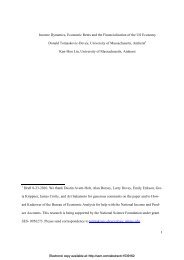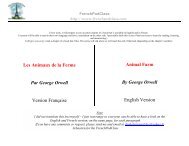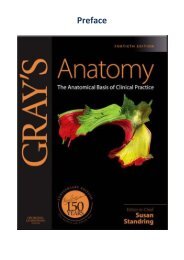Corporate governance and firm valuation
Corporate governance and firm valuation
Corporate governance and firm valuation
Create successful ePaper yourself
Turn your PDF publications into a flip-book with our unique Google optimized e-Paper software.
418 L.D. Brown, M.L. Caylor / Journal of Accounting <strong>and</strong> Public Policy 25 (2006) 409–434<br />
Table 2<br />
Regressions of Tobin’s Q on Gov-Score <strong>and</strong> controls (1868 <strong>firm</strong>s)<br />
Intercept Gov-Score Log (Assets) Log (Firm Age) Delaware dummy Adj. R 2<br />
0.46999** 0.031432*** 0.08119*** 0.054118 0.044813 1.89%<br />
( 2.27) (3.75) ( 3.89) (1.59) (0.76)<br />
Tobin’s Q is regressed on Gov-Score <strong>and</strong> the control variables. Tobin’s Q is industry mean-adjusted<br />
using the 23 ISS defined industries after winsorizing the top <strong>and</strong> bottom 1% of its distribution.<br />
Tobin’s Q is defined as: (Total Assets (Compustat Annual Item 6) + Market Value of Equity (Stock<br />
Price Fiscal Year Close (Compustat Annual Item 199) * Common Shares Outst<strong>and</strong>ing (Compustat<br />
Annual Item 25)) Total Common Equity (Compustat Annual Item 60) Deferred Taxes (Balance<br />
Sheet) (Compustat Annual Item 74))/Total Assets. Gov-Score is the summation of <strong>governance</strong><br />
provisions that are considered minimally acceptable (see Appendix for 51 provisions). The control<br />
variables are natural logarithm of total assets, natural logarithm of <strong>firm</strong> age as measured in fiscal<br />
quarters, <strong>and</strong> a dummy variable indicating whether a <strong>firm</strong> is incorporated in Delaware or not<br />
(coded 1 <strong>and</strong> 0, respectively). The t-statistics are reported in parentheses below coefficient estimates.<br />
t-Statistics are based on White-adjusted st<strong>and</strong>ard errors.<br />
*** (**) Indicates significance at 1% (5%), two-tailed level.<br />
<strong>and</strong> the Delaware dummy are negative. The Spearman <strong>and</strong> Pearson correlations<br />
between log of assets <strong>and</strong> log of <strong>firm</strong> age are positive. The only other significant<br />
correlations among the control variables are a negative Spearman<br />
between the Delaware dummy <strong>and</strong> log of <strong>firm</strong> age <strong>and</strong> a negative Pearson<br />
between the Delaware dummy <strong>and</strong> log of <strong>firm</strong> assets.<br />
Table 2 presents results of regressions of Tobin’s Q on Gov-Score <strong>and</strong> the<br />
control variables. Gov-Score is significant at the 1% level (coefficient estimate<br />
= 0.031432, t-statistic = 3.75), revealing that <strong>firm</strong> performance is positively<br />
related to our summary measure of corporate <strong>governance</strong>. The only<br />
significant control variable is log of assets (coefficient estimate = 0.08119, tstatistic<br />
= 3.89).<br />
5. Which factors drive the relation between <strong>firm</strong> <strong>valuation</strong> <strong>and</strong> Gov-Score?<br />
We refer to the three approaches described in Section 3 above to determine<br />
which provisions underlying Gov-Score drive the relation between Gov-Score<br />
<strong>and</strong> <strong>firm</strong> value as ALL, BCF <strong>and</strong> STEP, respectively, <strong>and</strong> we identify the drivers<br />
using each one.<br />
5.1. ALL approach<br />
Our first approach regresses Tobin’s Q on all 51 ISS factors <strong>and</strong> the three<br />
control variables. Untabulated results reveal that the highest variance inflation<br />
factor among our independent variables is 2.81, well below the commonly used<br />
cutoff of 10 indicating multicollinearity problems, so we include all 51 factors<br />
in our model. Table 3 shows the six <strong>governance</strong> factors that are significant <strong>and</strong>







